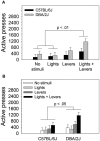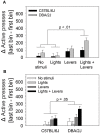Stimulus Complexity and Mouse Strain Drive Escalation of Operant Sensation Seeking Within and Across Sessions in C57BL/6J and DBA/2J Mice
- PMID: 31998094
- PMCID: PMC6965071
- DOI: 10.3389/fnbeh.2019.00286
Stimulus Complexity and Mouse Strain Drive Escalation of Operant Sensation Seeking Within and Across Sessions in C57BL/6J and DBA/2J Mice
Abstract
Sensation seeking is a heritable trait that is genetically correlated with substance use; the shared genetic mechanisms underlying these traits are largely unknown. The relationship of sensation seeking and substance use has practical importance because discovering genes that drive sensation seeking can reveal genes driving substance use, and quantification of sensation seeking in mice is higher throughput and less technically challenging than quantification of volitional drug use. In order to fully understand the genetic mechanisms driving sensation seeking, it is critical to first understand the nongenetic factors driving sensation seeking. In the present study, we used the operant sensation seeking paradigm to assess the effects of stimulus complexity on sensation seeking in C57BL/6J and DBA/2J mice. These strains are the founders of the BXD recombinant inbred mouse panel which enables the discovery of genes driving phenotypic variation. This study led to four principal conclusions. First, all sensory stimuli used in the study, regardless of complexity or number of stimulus modalities, served as reinforcers for C57BL/6J and DBA/2J mice. Second, for both C57BL/6J and DBA/2J mice, sensation seeking for a high complexity sensory stimulus was significantly greater than sensation seeking for a low complexity sensory stimulus. Third, for both C57BL/6J and DBA/2J mice, sensation seeking escalated significantly within-session when a multimodal sensory stimulus of medium or high complexity was used but not when a unimodal sensory stimulus of low complexity was used. Finally, both the magnitude of sensation seeking and the magnitude of within-session escalation of sensation seeking were significantly greater in mice from the DBA/2J strain relative to mice from the C57BL/6J strain. Collectively, these findings indicate that stimulus complexity and genetic background drive escalation of operant sensation seeking within and across sessions, and that the BXD recombinant inbred mouse panel can be used to discover the genetic mechanisms underlying these phenomena.
Keywords: BXD; addiction; habituation; novelty seeking; reward; sensitization; substance use; systems genetics.
Copyright © 2020 Dickson and Mittleman.
Figures




Similar articles
-
Strain and sex dependent effects of isolation housing relative to environmental enrichment on operant sensation seeking in mice.Sci Rep. 2021 Sep 8;11(1):17826. doi: 10.1038/s41598-021-97252-0. Sci Rep. 2021. PMID: 34497303 Free PMC article.
-
Effects of isolation housing stress and mouse strain on intravenous cocaine self-administration, sensory stimulus self-administration, and reward preference.Sci Rep. 2023 Feb 16;13(1):2810. doi: 10.1038/s41598-023-29579-9. Sci Rep. 2023. PMID: 36797314 Free PMC article.
-
Systems genetics of sensation seeking.Genes Brain Behav. 2019 Mar;18(3):e12519. doi: 10.1111/gbb.12519. Epub 2018 Oct 8. Genes Brain Behav. 2019. PMID: 30221471 Free PMC article.
-
Environmental enrichment influences novelty reactivity, novelty preference, and anxiety via distinct genetic mechanisms in C57BL/6J and DBA/2J mice.Sci Rep. 2021 Feb 16;11(1):3928. doi: 10.1038/s41598-021-83574-6. Sci Rep. 2021. PMID: 33594184 Free PMC article.
-
Strain-dependent differences in corticolimbic processing of aversive or rewarding stimuli.Front Syst Neurosci. 2015 Feb 4;8:207. doi: 10.3389/fnsys.2014.00207. eCollection 2014. Front Syst Neurosci. 2015. PMID: 25698940 Free PMC article. Review.
Cited by
-
Operant novelty seeking predicts cue-induced reinstatement following cocaine but not water reinforcement in male rats.Psychopharmacology (Berl). 2023 Oct;240(10):2201-2215. doi: 10.1007/s00213-023-06441-4. Epub 2023 Aug 8. Psychopharmacology (Berl). 2023. PMID: 37552291 Free PMC article.
-
Strain and sex dependent effects of isolation housing relative to environmental enrichment on operant sensation seeking in mice.Sci Rep. 2021 Sep 8;11(1):17826. doi: 10.1038/s41598-021-97252-0. Sci Rep. 2021. PMID: 34497303 Free PMC article.
-
An operant ethanol self-administration paradigm that discriminates between appetitive and consummatory behaviors reveals distinct behavioral phenotypes in commonly used rat strains.Neuropharmacology. 2021 Dec 15;201:108836. doi: 10.1016/j.neuropharm.2021.108836. Epub 2021 Oct 12. Neuropharmacology. 2021. PMID: 34648771 Free PMC article.
-
Effects of isolation housing stress and mouse strain on intravenous cocaine self-administration, sensory stimulus self-administration, and reward preference.Sci Rep. 2023 Feb 16;13(1):2810. doi: 10.1038/s41598-023-29579-9. Sci Rep. 2023. PMID: 36797314 Free PMC article.
-
Jugular Vein Catheter Design and Cocaine Self-Administration Using Mice: A Comprehensive Method.Front Behav Neurosci. 2022 Jun 15;16:880845. doi: 10.3389/fnbeh.2022.880845. eCollection 2022. Front Behav Neurosci. 2022. PMID: 35783231 Free PMC article.
References
-
- American Psychiatric Association (2013). Diagnostic and Statistical Manual of Mental Disorders. 5th Edn. Washington, DC: American Psychiatric Association.
-
- Ashbrook D. G., Arends D., Prins P., Mulligan M. K., Roy S., Williams E. G., et al. (2019). The expanded BXD family of mice: a cohort for experimental systems genetics and precision medicine. bioRxiv [Preprint]. 10.1101/672097 - DOI
Grants and funding
LinkOut - more resources
Full Text Sources
Molecular Biology Databases

